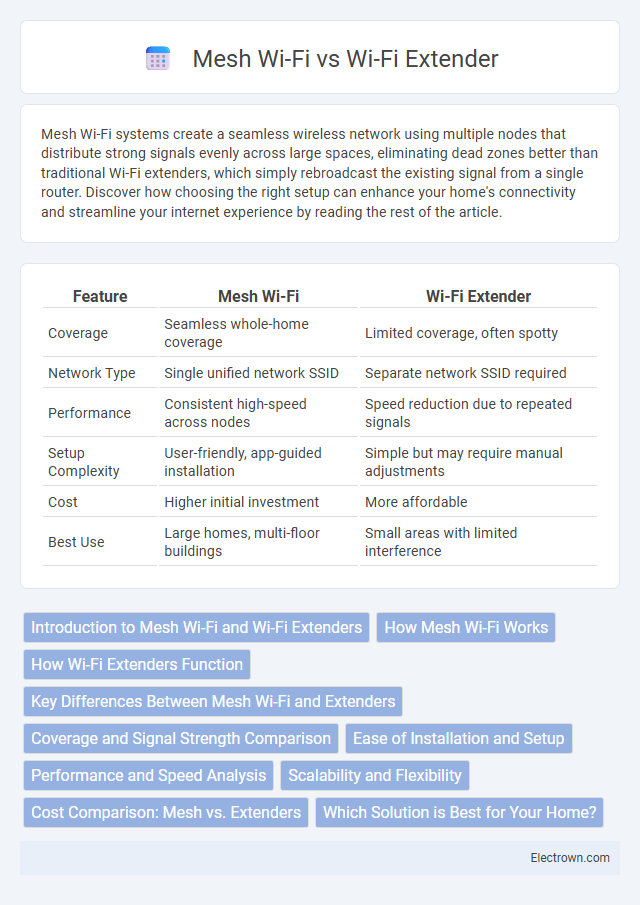Mesh Wi-Fi systems create a seamless wireless network using multiple nodes that distribute strong signals evenly across large spaces, eliminating dead zones better than traditional Wi-Fi extenders, which simply rebroadcast the existing signal from a single router. Discover how choosing the right setup can enhance your home's connectivity and streamline your internet experience by reading the rest of the article.
Table of Comparison
| Feature | Mesh Wi-Fi | Wi-Fi Extender |
|---|---|---|
| Coverage | Seamless whole-home coverage | Limited coverage, often spotty |
| Network Type | Single unified network SSID | Separate network SSID required |
| Performance | Consistent high-speed across nodes | Speed reduction due to repeated signals |
| Setup Complexity | User-friendly, app-guided installation | Simple but may require manual adjustments |
| Cost | Higher initial investment | More affordable |
| Best Use | Large homes, multi-floor buildings | Small areas with limited interference |
Introduction to Mesh Wi-Fi and Wi-Fi Extenders
Mesh Wi-Fi systems use multiple interconnected nodes to provide seamless wireless coverage across large areas, eliminating dead zones and maintaining consistent speeds. Wi-Fi extenders, also known as repeaters, amplify the existing router's signal but often create separate networks and may reduce overall bandwidth. Understanding the fundamental differences in technology and network architecture helps determine the best solution for robust home or office Wi-Fi performance.
How Mesh Wi-Fi Works
Mesh Wi-Fi systems use multiple interconnected nodes to create a seamless, unified wireless network that covers your entire home with strong, consistent signals. Each node communicates with others to route data efficiently, reducing dead zones and improving overall network performance compared to traditional Wi-Fi extenders, which simply rebroadcast signals from a single router. Your devices automatically connect to the nearest node, ensuring optimal speed and reliability throughout your space.
How Wi-Fi Extenders Function
Wi-Fi extenders function by receiving the existing Wi-Fi signal from a router and rebroadcasting it to areas with weak or no coverage, effectively increasing the overall reach of the wireless network. They connect to the main router either wirelessly or via Ethernet, creating a secondary network that devices can connect to, though this often results in reduced bandwidth and increased latency compared to the original network. Wi-Fi extenders are ideal for eliminating dead zones in smaller spaces but may struggle to provide seamless coverage over larger or multi-story homes compared to mesh Wi-Fi systems.
Key Differences Between Mesh Wi-Fi and Extenders
Mesh Wi-Fi systems use multiple nodes to create a seamless, unified network with consistent coverage, while Wi-Fi extenders simply rebroadcast your existing signal, often resulting in reduced speed and separate network names. Mesh networks optimize device connections dynamically, providing better performance in large or multi-story homes compared to extenders that can cause dead zones and reliability issues. Understanding these key differences helps you choose the best solution to improve your home Wi-Fi coverage and speed effectively.
Coverage and Signal Strength Comparison
Mesh Wi-Fi systems provide seamless coverage by using multiple nodes that communicate with each other, creating a unified network with strong signal strength throughout your entire home. Wi-Fi extenders boost the signal from a single router but often create separate networks and may experience signal degradation, especially at extended distances. Your choice between the two impacts how effectively your devices maintain consistent connectivity in areas with weak or no original Wi-Fi coverage.
Ease of Installation and Setup
Mesh Wi-Fi systems offer seamless ease of installation and setup by automatically connecting multiple nodes to create a unified network with minimal user intervention. In contrast, Wi-Fi extenders often require manual configuration and may involve complex steps to extend the existing signal, which can lead to inconsistent coverage and connection drops. Your best choice for straightforward, user-friendly home networking is a mesh Wi-Fi system due to its automated setup and self-configuring capabilities.
Performance and Speed Analysis
Mesh Wi-Fi systems deliver seamless coverage by using multiple nodes that communicate to create a single, high-speed network, reducing dead zones and maintaining consistent performance throughout large areas. Wi-Fi extenders often suffer from signal degradation and slower speeds because they rebroadcast the original signal, leading to increased latency and possible bandwidth loss. For optimal performance and speed, mesh Wi-Fi is superior in managing network traffic and ensuring uniform connectivity across multiple devices in complex environments.
Scalability and Flexibility
Mesh Wi-Fi systems offer superior scalability by allowing users to easily add multiple nodes that seamlessly connect to form a unified network with consistent coverage and performance. In contrast, Wi-Fi extenders provide limited flexibility as they typically extend the signal from a single router, often resulting in reduced speeds and separate network names. Mesh networks adapt dynamically to changing environments, making them ideal for expanding coverage in larger homes or offices without compromising connectivity quality.
Cost Comparison: Mesh vs. Extenders
Mesh Wi-Fi systems typically cost between $150 and $500 for a multi-unit setup, providing seamless whole-home coverage through integrated nodes, while Wi-Fi extenders range from $30 to $100 but often deliver limited coverage and slower speeds due to signal rebroadcasting. Although extenders have a lower upfront cost, the need for multiple units to cover large areas can increase expenses and complicate network management compared to the scalable nature of mesh networks. Your investment in a mesh system offers more reliable performance and easier expansion, balancing initial cost with long-term value.
Which Solution is Best for Your Home?
Mesh Wi-Fi systems provide seamless coverage by creating a unified network with multiple nodes, ideal for large or multi-story homes requiring consistent internet strength. Wi-Fi extenders boost an existing signal but often result in slower speeds and separate networks, making them more suitable for smaller areas with specific dead zones. Choosing between the two depends on home size, internet usage demands, and budget, with mesh offering superior performance and scalability for comprehensive coverage.
Mesh Wi-Fi vs Wi-Fi Extender Infographic

 electrown.com
electrown.com